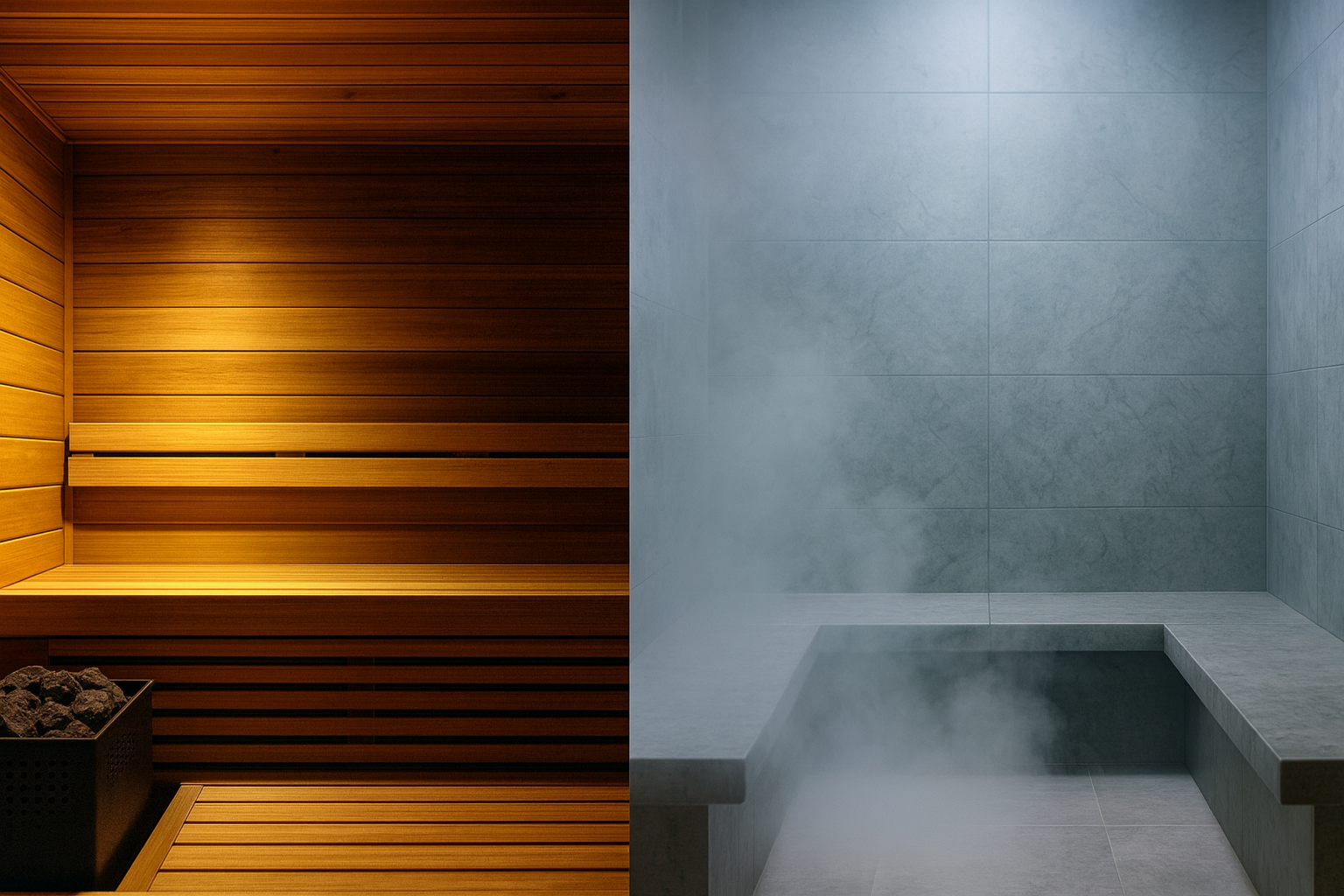
Red Light Therapy vs Infrared Sauna: Which One Should You Try?
Are you considering trying red light therapy or an infrared sauna to boost your wellness? Both therapies have gained popularity for their potential health benefits, but which one is right for you?

Red light therapy uses low-level laser or light-emitting diodes to promote cellular rejuvenation, while infrared saunas use heat to detoxify and relax the body. Understanding the differences between these two therapies can help you make an informed decision.
This article will compare the benefits and differences between red light therapy and infrared sauna therapy, helping you decide which one to try.
Key Takeaways
- Red light therapy promotes cellular rejuvenation.
- Infrared saunas detoxify and relax the body.
- Both therapies have unique benefits.
- Understanding the differences is key to making a decision.
- Consult a healthcare professional before trying either therapy.
Understanding Light-Based Wellness Therapies
As interest in holistic health practices grows, light-based wellness therapies are emerging as a promising avenue for those seeking non-pharmacological interventions. Light-based wellness encompasses various treatments that utilize different wavelengths of light to promote health and wellbeing.
The Growing Popularity of Light Therapies
Light therapies have seen a significant surge in popularity as individuals look for alternative methods to improve their health. This growth is attributed to the increasing awareness of the benefits of light therapy, including its ability to enhance mood, improve skin health, and aid in pain management. The non-invasive nature of these therapies makes them particularly appealing.
The rise in popularity can also be linked to advancements in technology, making light therapy devices more accessible for home use. As a result, what was once a treatment primarily found in clinical settings is now becoming a staple in many personal wellness routines.
How Light Affects the Human Body
Different wavelengths of light have varying effects on the human body. For instance, red light therapy is known for its ability to stimulate cellular processes, promoting healing and reducing inflammation. On the other hand, infrared light penetrates deeper into the body, heating tissues and improving circulation.
The science behind light therapy is rooted in its ability to interact with cells, influencing their behavior and promoting health benefits. By understanding how different wavelengths affect the body, individuals can make informed decisions about which light-based therapy is best suited to their needs.
What Is Red Light Therapy?
Red light therapy, also known as low-level laser therapy or photobiomodulation, is a treatment that uses red or near-infrared light to stimulate cellular processes. This non-invasive therapy has been gaining popularity due to its potential benefits for overall wellness, including improved skin health, reduced pain, and enhanced muscle recovery.
The Science Behind Red Light Therapy
The science behind red light therapy is based on the principle that certain wavelengths of light can be absorbed by cells, leading to increased energy production and subsequent therapeutic effects. Red light, typically in the 630-700nm range, and near-infrared light, typically in the 700-1100nm range, are used to stimulate cellular processes, promoting healing and reducing inflammation.
https://www.youtube.com/watch?v=DUqQBGrKXPU
Common Red Light Therapy Devices
Red light therapy devices come in various forms, including LED panels, laser devices, and handheld units. These devices emit specific wavelengths of red or near-infrared light, which are then absorbed by the body. Some common devices used for red light therapy include:
- LED masks for facial treatments
- Red light panels for full-body treatments
- Handheld devices for targeted areas
Treatment Protocols and Time Commitment
Treatment protocols for red light therapy vary depending on the specific condition being treated and the device being used. Generally, treatments can range from 10-30 minutes per session, with multiple sessions per week. A typical treatment protocol may involve:
| Treatment Area | Session Duration | Frequency |
|---|---|---|
| Face | 10-15 minutes | 3-5 times a week |
| Full Body | 20-30 minutes | 2-3 times a week |
| Targeted Areas | 5-10 minutes | Daily |
What Is an Infrared Sauna?
As a therapeutic and detoxifying tool, infrared saunas are becoming increasingly popular. Unlike traditional saunas that rely on steam to heat the body, infrared saunas use infrared heaters to emit infrared light experienced as radiant heat.
Infrared saunas are designed to provide a more comfortable and efficient heating experience. The infrared heat is absorbed directly by the body, allowing for a deeper sweat at a lower temperature than traditional saunas.
How Infrared Saunas Work
Infrared saunas work by emitting infrared radiation that is absorbed by the body, causing the body temperature to rise. This process promotes sweating, which is believed to help remove toxins from the body. The heat also helps to relax muscles and improve circulation.
Types of Infrared Saunas
There are several types of infrared saunas available, including:
- Full-spectrum infrared saunas, which emit a wide range of infrared frequencies.
- Near-infrared saunas, which are believed to have skin rejuvenating properties.
- Far-infrared saunas, which penetrate deeper into the body and are often used for therapeutic purposes.
| Type of Infrared Sauna | Benefits |
|---|---|
| Full-spectrum | Wide range of infrared frequencies for overall wellness |
| Near-infrared | Skin rejuvenation and improved appearance |
| Far-infrared | Deep penetration for therapeutic benefits |
Typical Session Duration and Frequency
A typical infrared sauna session can last anywhere from 20 to 45 minutes. For optimal benefits, it's recommended to use the sauna 2-3 times a week. However, the frequency and duration can be adjusted based on individual health goals and comfort level.
Red Light Therapy vs Infrared Sauna: Key Differences
Red light therapy and infrared sauna are two distinct approaches to wellness, each with its unique benefits and characteristics. Understanding their differences is essential for individuals looking to incorporate one or both into their health regimen.
Wavelength and Penetration Differences
The primary difference between red light therapy and infrared sauna lies in their wavelengths and how deeply they penetrate the body. Red light therapy typically uses wavelengths between 630-700 nanometers, which are absorbed by the skin and underlying tissues, promoting healing and rejuvenation. In contrast, infrared saunas emit longer wavelengths, usually between 700-14000 nanometers, which penetrate deeper into the body, generating heat and promoting detoxification.
| Therapy | Wavelength Range | Penetration Depth |
|---|---|---|
| Red Light Therapy | 630-700 nm | Superficial to moderate |
| Infrared Sauna | 700-14000 nm | Deeper penetration |
Heat vs No Heat Therapy
Another significant difference is the presence or absence of heat. Infrared saunas are designed to produce heat, causing the body to sweat and potentially aiding in detoxification and weight loss. Red light therapy, on the other hand, does not emit significant heat and is more focused on the therapeutic benefits of specific wavelengths of light.
Red light therapy is ideal for those seeking the benefits of light without the heat, while infrared saunas are better suited for individuals looking for a heat-based therapy.

User Experience Comparison
The user experience differs significantly between the two therapies. Red light therapy sessions are typically shorter, lasting anywhere from a few minutes to 20-30 minutes, and can be done in a variety of settings, including at home with personal devices. Infrared sauna sessions, while also variable in duration, often last longer, typically around 20-45 minutes, and are usually conducted in a dedicated sauna setup.
In conclusion, the choice between red light therapy and infrared sauna depends on individual preferences and health goals. By understanding their key differences, users can make informed decisions about which therapy is most suitable for their needs.
Health Benefits of Red Light Therapy
Red light therapy has been gaining attention for its numerous health benefits, ranging from improved skin health to enhanced muscle recovery. This non-invasive treatment involves exposure to low-level red or near-infrared light, which is believed to stimulate cellular processes that can lead to various health improvements.
Skin Health and Anti-Aging Effects
One of the most popular benefits of red light therapy is its positive impact on skin health. It is known to increase collagen production, reduce fine lines and wrinkles, and improve skin texture. Studies have shown that red light therapy can also help in managing skin conditions like acne and psoriasis by reducing inflammation and promoting healing.
Pain Relief and Inflammation Reduction
Red light therapy has been found to be effective in reducing pain and inflammation in the body. It works by increasing blood flow to the affected areas, reducing oxidative stress, and promoting the release of pain-relieving chemicals. This makes it a valuable treatment option for individuals suffering from chronic pain conditions such as arthritis.
Muscle Recovery and Athletic Performance
Athletes are increasingly using red light therapy to enhance muscle recovery after workouts. The therapy helps in reducing muscle soreness and improving recovery times by promoting cellular repair and reducing oxidative stress. This can lead to improved athletic performance over time.
Sleep and Mood Improvements
Exposure to red light therapy has also been linked to improvements in sleep quality and mood. It is believed to work by regulating the body's circadian rhythms and increasing the production of neurotransmitters that are associated with improved mood, such as serotonin.
Health Benefits of Infrared Saunas
Infrared sauna therapy offers a multitude of health advantages, making it a sought-after treatment in wellness centers. Regular use of infrared saunas has been linked to various benefits that can enhance overall health and wellbeing.
Detoxification and Improved Circulation
One of the primary benefits of infrared saunas is their ability to promote detoxification through sweating. The deep penetration of infrared heat encourages the body to sweat profusely, helping to remove toxins. Additionally, infrared saunas improve circulation by causing blood vessels to dilate, which can help in healing and reducing inflammation.
Weight Loss and Metabolic Effects
Infrared saunas can also aid in weight loss by increasing heart rate and improving metabolism. Regular sessions can help burn calories and reduce body fat. Some studies suggest that infrared sauna use can improve insulin sensitivity, further contributing to metabolic health.

Relaxation and Stress Reduction
The warmth of an infrared sauna provides a calming and relaxing experience, helping to reduce stress and promote mental wellbeing. The heat therapy can help relax muscles, reduce pain, and improve sleep quality by promoting relaxation.
Cardiovascular Benefits
Regular infrared sauna use has been associated with cardiovascular benefits, including lower blood pressure and improved heart health. The heat stress from sauna use can help strengthen the heart, similar to the effects of exercise.
| Health Benefit | Description |
|---|---|
| Detoxification | Promotes sweating to remove toxins |
| Weight Loss | Increases metabolism and burns calories |
| Relaxation | Reduces stress and promotes mental wellbeing |
| Cardiovascular Health | Lowers blood pressure and improves heart health |
Safety Considerations for Both Therapies
When considering red light therapy or infrared saunas, it's crucial to understand the safety aspects to ensure a safe and beneficial experience. Both therapies, while generally considered safe, come with certain precautions and contraindications that users should be aware of.
Who Should Avoid Red Light Therapy
Red light therapy is not suitable for everyone. Individuals with certain medical conditions or those taking specific medications should exercise caution. For instance, people with porphyria or those taking medications that cause light sensitivity should avoid red light therapy. Pregnant women and individuals with active cancer should also consult their healthcare provider before starting treatment.
Who Should Avoid Infrared Saunas
Infrared saunas are not recommended for individuals with certain health conditions. People with heart disease, high blood pressure, or those who are pregnant should consult their doctor before using an infrared sauna. Additionally, individuals with metal implants or those taking certain medications should also seek medical advice.
Potential Side Effects and Precautions
While both therapies are generally safe, there are potential side effects to be aware of. Red light therapy can cause temporary eye strain or skin irritation in some individuals. Infrared saunas can lead to dehydration or heat exhaustion if not used properly. It's essential to follow the manufacturer's guidelines and consult with a healthcare professional if you have any concerns.
Cost Comparison and Accessibility
To determine which therapy is more accessible, it's essential to compare the costs associated with red light therapy and infrared saunas. The financial investment for these therapies can vary widely based on the type of device or service chosen.
Investment for Home Use
For those considering home use, the initial investment for red light therapy devices can range from $200 to $1,000, depending on the device's quality and features. Infrared saunas, on the other hand, can cost anywhere from $500 to $3,000 or more, depending on the size and type of sauna.
Commercial Services and Spa Options
For those who prefer not to invest in home devices, commercial services and spa options are available. The cost per session for red light therapy can range from $30 to $100, while infrared sauna sessions can cost between $20 to $50 per session. Many spas offer package deals that can reduce the cost per session.
Long-Term Cost Considerations
When evaluating long-term costs, it's crucial to consider the maintenance and operational costs associated with each therapy. Red light therapy devices are generally low maintenance, while infrared saunas may require more upkeep, including cleaning and potentially replacing heating elements.
| Therapy Type | Initial Cost | Cost per Session (Commercial) | Maintenance Cost |
|---|---|---|---|
| Red Light Therapy | $200-$1,000 | $30-$100 | Low |
| Infrared Sauna | $500-$3,000 | $20-$50 | Moderate to High |
By understanding these costs, individuals can make a more informed decision about which therapy best fits their budget and wellness goals.
Which Therapy Is Right for Your Goals?
Understanding your wellness goals is key to deciding between the benefits of red light therapy and infrared sauna. Both therapies offer unique advantages, and making an informed decision requires a closer look at what you aim to achieve.
Best Choice for Skin Concerns
If your primary goal is to improve skin health, red light therapy is the preferred option. It has been shown to enhance collagen production, reduce fine lines, and improve skin texture. Red light therapy devices emit specific wavelengths that penetrate the skin, promoting cellular rejuvenation.
Best Choice for Pain Management
For those seeking relief from pain and inflammation, red light therapy is again a viable choice. It works by increasing blood flow and reducing oxidative stress in the affected areas. However, infrared sauna therapy can also be beneficial for pain management by promoting deep relaxation and reducing muscle tension.
Best Choice for Detoxification and Weight Loss
If your goal is detoxification or weight loss, an infrared sauna is likely the better choice. Infrared saunas cause profuse sweating, which can help remove toxins from the body and aid in weight loss efforts. Regular sessions can also improve cardiovascular health.
Best Choice for Stress and Mental Wellbeing
Both therapies can help reduce stress, but an infrared sauna is particularly effective for mental wellbeing. The deep relaxation induced by the sauna can lower cortisol levels, reduce anxiety, and promote a sense of calm.
In conclusion, your specific wellness goals will dictate whether red light therapy or infrared sauna is the most suitable choice for you. Consider what you want to achieve and choose the therapy that aligns best with your objectives.
Conclusion: Making Your Wellness Choice
Choosing between red light therapy and infrared sauna depends on your individual wellness goals. Both therapies offer unique benefits, from improved skin health and pain relief to detoxification and stress reduction.
Red light therapy is ideal for those seeking to improve skin health, reduce pain and inflammation, and enhance athletic performance. On the other hand, infrared saunas are better suited for individuals looking to detoxify, lose weight, and reduce stress.
When making your wellness choice, consider your specific needs and preferences. If you're looking for a low-heat, non-invasive treatment, red light therapy might be the better option. For those who enjoy the heat and relaxation of a sauna experience, infrared sauna is the way to go.
Ultimately, both red light therapy and infrared sauna can be valuable additions to your wellness routine. By understanding the benefits and differences between these therapies, you can make an informed decision that aligns with your goals and enhances your overall wellbeing.
FAQ
What is the main difference between red light therapy and infrared sauna?
The primary difference lies in their therapeutic approach; red light therapy uses specific wavelengths of light to promote cellular healing, while infrared saunas use infrared radiation to heat the body, promoting detoxification and relaxation.
Can I use red light therapy and infrared sauna together?
Yes, many people combine both therapies as part of their wellness routine, as they offer complementary benefits that can enhance overall health and wellbeing.
Are there any side effects associated with red light therapy?
Red light therapy is generally considered safe, with minimal side effects; however, some individuals may experience temporary eye strain or headaches, and it's recommended to follow proper guidelines and consult with a healthcare professional if concerns arise.
How often should I use an infrared sauna?
The frequency of infrared sauna use can vary depending on individual goals and health status; typically, using it 2-3 times a week is recommended, but it's essential to listen to your body and adjust accordingly.
Can I purchase red light therapy devices or infrared saunas for home use?
Yes, both red light therapy devices and infrared saunas are available for home use, offering a convenient way to incorporate these therapies into your daily routine; when selecting a device or sauna, consider factors such as quality, safety features, and customer reviews.
Are there any specific health conditions that may prevent me from using red light therapy or infrared sauna?
Certain health conditions, such as pregnancy, epilepsy, or severe cardiovascular disease, may require caution or avoidance of these therapies; it's crucial to consult with a healthcare professional before starting red light therapy or using an infrared sauna, especially if you have any underlying medical conditions.
How long does a typical red light therapy session last?
The duration of a red light therapy session can vary, but typically ranges from 10 to 30 minutes, depending on the specific treatment protocol and device being used.
Can I use red light therapy or infrared sauna if I have a pacemaker or other implants?
Individuals with pacemakers or other implants should consult their healthcare provider before using red light therapy or infrared saunas, as certain conditions may be contraindicated.







Leave a comment
This site is protected by hCaptcha and the hCaptcha Privacy Policy and Terms of Service apply.